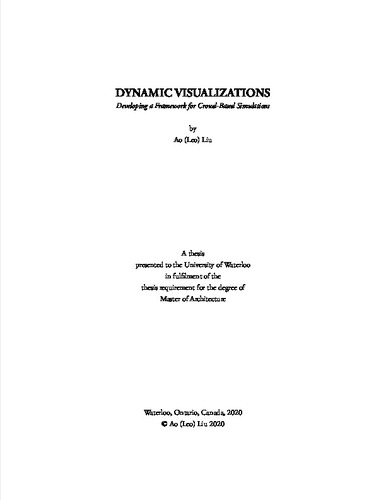| dc.description.abstract | Since its conception in the 1960s, digital computation has experienced both
exponential growth in power and reduction in cost. This has allowed the production
of relatively cheap electronics, which are now integrated ubiquitously in daily life.
With so much computational data and an ever-increasing accessibility to intelligent
objects, the potential for integrating such technologies within architectural systems
becomes increasingly viable. Today, dynamic architecture is already emerging across
the world; it is inevitable that one day computation will be fully integrated within the
infrastructures of our cities.
However, as these new forms of dynamic architecture becomes increasingly
commonplace, the standard static medium of architectural visualization is no longer
satisfactory for representing and visualizing these dynamic spaces, let alone the
human interactions within them. Occupancy within a space is already inherently
dynamic and becomes even more so with the introduction of these new forms of
architecture. This in turn challenges our conventional means of visualizing spaces
both in design and communication. To fully represent dynamic architecture, the
visualization must be dynamic as well. As such, current single image rendering
methods within most existing architectural design pipelines becomes inadequate in
portraying both the architectural dynamics of the space, as well as the interaction
and influences these dynamics will have with the occupants.
This thesis aims to mitigate these shortcomings in architectural visualization by
investigating the creation of a crowd simulation tool to facilitate a foundation for
a visualization framework that can be continuously built upon based on project
needs, which answers the question of how one can utilize current technologies
to not only better represent responsive architecture but also to optimize existing
visualization methodologies. By using an interdisciplinary approach that brings
together architecture, computer science, and game design, it becomes possible to
establish a more powerful, flexible, and efficient workflow in creating architectural
visualizations.
Part One will establish a foundation to this thesis by looking at the state of
the current world, its buildings in the sense of dynamic, and the current state of
visualization technologies that are being utilized both within architectural design
as well as outside of it. Part Two will investigate complex systems and simulation
models, as well as investigating ways of integrating them with human behaviors to
establish a methodology for creating a working crowd simulation system. Part Three
will take the methodology developed within Part Two and integrate it within modern
game engines, with the intent of creating an architectural visualization pipeline that
can utilize the game engine for both crowd analytics as well as visualization. Part
Four will look at some of the various spatial typologies that can be visualized with
this tool. Finally, Part Five will speculate on various future directions to improve this
tool beyond the current scope of this thesis. | en |

